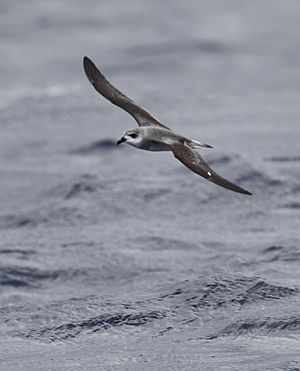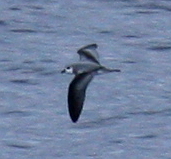Black-winged petrel facts for kids
Quick facts for kids Black-winged petrel |
|
|---|---|
 |
|
| Conservation status | |
| Scientific classification | |
| Genus: |
Pterodroma
|
| Species: |
nigripennis
|
The black-winged petrel (Pterodroma nigripennis) is a type of seabird that belongs to the Procellariidae family. These birds live on many islands in the warm and mild parts of the East Pacific Ocean. They spend most of their lives flying over the sea, only coming to land to lay their eggs.
What it Looks Like
The black-winged petrel is a small bird with long, thin wings. It is about 29 centimeters (11 inches) long. Its wings can spread out to about 67 centimeters (26 inches).
This petrel has a small head and a short, black beak. Its body is slender, and its tail is cut straight across. The top of its head and neck are light grey. Its cheeks are white, and it has a dark grey band around its neck. The back of its body is light grey. The top of its wings are light grey near the body but become dark grey-black towards the tips. Its belly and chest are white. The outer edges of its wings are black, and its tail has black and white stripes.
Where it Lives
The black-winged petrel is a bird of the open ocean, also called the pelagic zone. It lives in the East Pacific Ocean. It only comes to land when it's time to breed.
Its breeding areas stretch from Lord Howe Island and eastern Australia. They also breed in New Caledonia, the Chatham Islands, and the Austral Islands in French Polynesia. When they are not breeding, these birds travel further north. You can often find them in a wide area of the ocean between Peru and Hawaii.
How it Lives
Since these birds live mostly in the open ocean, we don't know a lot about what they eat. They usually catch their food by skimming over the water's surface. They might also pat their feet on the water to grab prey. Their diet includes cephalopods (like squid) and prawns. Sometimes, they hunt for fish alongside other birds from their group, called Procellariiformes.
Black-winged petrels breed on tropical and subtropical islands in the Pacific Ocean. They dig a tunnel in sandy soil, often on a grassy slope away from the beach. The tunnel can be up to a meter (about 3 feet) long. The entrance to their nest is often hidden by bushes. Inside, they lay just one egg in a special chamber. They line this nest with leaves and other soft materials.
The egg takes about 45 days to hatch. Both parent birds help to feed the young chick. The young bird is ready to fledge (fly for the first time) after about 85 days.
Its Status
Scientists believe there are about eight to ten million black-winged petrels around the world. This is a very large number of birds. They are spread out over a wide area. Because of their large population, the IUCN has listed the black-winged petrel as a species of least concern. This means they are not currently in danger of disappearing.
See also
 In Spanish: Petrel Alinegro para niños
In Spanish: Petrel Alinegro para niños



